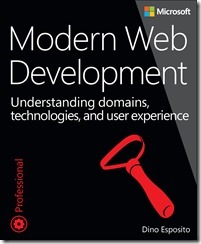New book: Modern Web Development: Understanding domains, technologies, and user experience
 We’re pleased to announce the availability of Modern Web Development: Understanding domains, technologies, and user experience (ISBN 9781509300013), by Dino Esposito.
We’re pleased to announce the availability of Modern Web Development: Understanding domains, technologies, and user experience (ISBN 9781509300013), by Dino Esposito.
Purchase from these online retailers: Microsoft Press Store Amazon.com Barnes & Noble Independent booksellers – Shop local
Master powerful new approaches to web architecture, design, and user experience
This book presents a pragmatic, problem-driven, user-focused approach to planning, designing, and building dynamic web solutions. You’ll learn how to gain maximum value from Domain-Driven Design (DDD), define optimal supporting architecture, and succeed with modern UX-first design approaches. The author guides you through choosing and implementing specific technologies and addresses key user-experience topics, including mobile-friendly and responsive design. You’ll learn how to gain more value from existing Microsoft technologies such as ASP.NET MVC and SignalR by using them alongside other technologies such as Bootstrap, AJAX, JSON, and JQuery. By using these techniques and understanding the new ASP.NET Core 1.0, you can quickly build advanced web solutions that solve today’s problems and deliver an outstanding user experience.
Microsoft MVP Dino Esposito shows you how to:
- Plan websites and web apps to mirror real-world social and business processes
- Use DDD to dissect and master the complexity of business domains
- Use UX-Driven Design to reduce costs and give customers what they want
- Realistically compare server-side and client-side web paradigms
- Get started with the new ASP.NET Core 1.0
- Simplify modern visual webpage construction with Bootstrap
- Master practical, efficient techniques for running ASP.NET MVC projects
- Consider new options for implementing persistence and working with data models
- Understand Responsive Web Design’s pros, cons, and tradeoffs
- Build truly mobile-friendly, mobile-optimized websites
About This Book
- For experienced developers and solution architects who want to plan and develop web solutions more effectively
- Assumes basic familiarity with the Microsoft web development stack
About the Author
Dino Esposito is CTO and cofounder of Crionet, a firm that provides web and mobile solutions for sporting events across Europe. A longtime trainer and consultant, he is an 11-time Microsoft MVP. His web/mobile development books include Microsoft .NET: Architecting Applications for the Enterprise, Second Edition and Architecting Mobile Solutions for the Enterprise. He speaks regularly at industry events, including Microsoft TechEd and premier European events such as SDD, BASTA, and Devweek. Follow him at software2cents.wordpress.com or twitter.com/despos.
Introduction
No later than the summer of 2008, I gave a few public talks about the future of the web. Customers who hired me at the time heard from this expert voice that the web of the (near) future would be significantly different than what it was looking like in 2008. At the time, the brilliant future of the web seemed to be in the hands of compiled code run from within the browser.
JavaScript? It’s dead, at last! ASP.NET? It’s gone, thankfully!
The future as I saw it back then (along with many other experts) had only rich-client technologies in store for millions of us. And Microsoft Silverlight stood at the center of the new web universe.
If you started hibernating in 2008 and woke up any time in the past three or even four years, you found a different world than I, or possibly you, had imagined. It was solidly server-side-based and different from what the expectations were. Today, you find a web world in which JavaScript reigns and, with it, a ton of ad hoc tools and frameworks.
Customers who paid good money to hear my expert voice back in 2008 tell them to invest in Silverlight are now paying good money to switch back more or less to where they were in 2008.
Well, not exactly.
This book comes at a weird time, but it’s not a weird book. Two decades of web experience taught us that real revolutions happen when, mostly due to rare astral alignments, a bunch of people happen to have the same programming needs. So it was for Ajax, and so it is today for responsive and interactive front ends. JavaScript has been revived because it is the simplest way for programmers to achieve goals. And because it is still effective enough to make solutions easy to sell.
Planning a web solution today means having a solid server-side environment to serve rich and interactive HTML pages, styled with CSS and actioned by JavaScript. Even though a lot of new ad hoc technologies have been developed, the real sticking points with modern applications (which are for the most part web applications) are domain analysis and the supporting architecture. Everything else revolves around the implementation of a few common practices for a few common tasks, some of which are relatively new requirements—for example, push notifications from the server.
In this book, you will find a summary of practices and techniques that guarantee effective solutions for your customers. The point today is no longer to use the latest release of the latest platform or framework. The point is just to give customers what they really want. Tools to build software exist; ideas and plans make the difference.